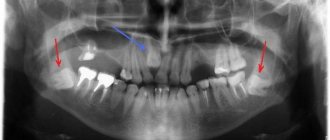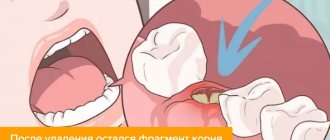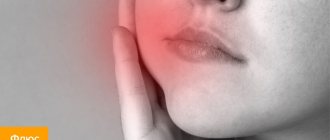From this article you will learn:
- Wisdom tooth removed - how long will it hurt?
- what are the complications?
- How long does it take for gums to heal after wisdom tooth removal?
The article was written by a dental surgeon with more than 19 years of experience.
According to statistics, after the removal of a wisdom tooth, inflammation of the socket of the extracted tooth occurs in 25-30% of cases. For example, after the removal of any other groups of teeth, inflammation occurs only in 3-5% of cases. This is due: firstly, to the higher complexity of removing wisdom teeth, and secondly, to the fact that they are surrounded by a large amount of soft tissue.
The last circumstance is very important, because the presence of moving soft tissues in the area of the extracted tooth socket often leads to the loss of the clot - its loss or even destruction. If the socket of the extracted tooth is not closed by a blood clot, inflammation will inevitably develop in it.
Gums after wisdom tooth removal (normal) –
When wisdom teeth are removed, stitches are almost always required. This is necessary because these teeth are located deep in the soft tissues and in this place the mucous membrane is very mobile. The absence of sutures in this situation can lead to prolapse of the clot and inflammation. But if the patient has a long jaw and there is enough space for the wisdom tooth, the socket will look traditional (Fig. 3).
To learn how the sockets of extracted teeth should normally heal, and how to speed up this process, read the article: “How long should gums take to heal?”
Carrying out the procedure
The tooth extraction procedure is carried out using effective, modern painkillers, so, as a rule, there is no pain during the operation itself.
The operation begins immediately after the anesthesia takes effect. A scalpel is used to loosen the ligament supporting the tooth.
If the procedure was traumatic, or the edges of the wound are too wide, the dental surgeon may use self-absorbing sutures. But most often, the wound is simply closed with a gauze pad with a special hemostatic agent. To stop bleeding, you need to lightly but firmly press the tampon onto the wound with closed jaws. After 20 minutes, the gauze can be spat out.
Main treatment methods
Your dentist will tell you what treatment and gum care should be like after tooth extraction. Only he can select the right drugs that are suitable specifically for your case.
Among the most common treatment methods are the following:
- Careful rinsing with preparations and tinctures with various herbal ingredients and antiseptics.
- Local application of soothing ointments and gels.
- Drug treatment. Your doctor may prescribe antibiotics, painkillers, and anti-inflammatory drugs. But we do not recommend using any medications without a prescription.
Gum condition
Pain in the gums may occur after the anesthetic drug wears off, that is, after 3-4 hours. After the procedure, the patient is often worried about the return of painful sensations and the release of ichor (for 4–6 hours. After the operation, the wound looks quite scary, especially if a wisdom tooth was removed.
In the absence of pathology, the healing process occurs in several stages.
How long does it take for a dry socket to heal?
Many people are interested in the question of how long it takes for a dry socket to heal. In the absence of complications, the wound heals in 5 - 7 days, and within a month the hole is filled with epithelial tissue. If you have dry socket, the healing process may take longer than two weeks (with proper treatment, of course). As already mentioned, extensive inflammation may occur and even require surgical hospitalization of the patient: in this case, the healing of the dry socket may be very delayed.
Day after the procedure
At the initial stage, the hole remaining in the place of the pulled out tooth is filled with a scarlet blood clot. It is not recommended to remove it, as it performs several functions:
- protects the wound from infections;
- eliminates bleeding from blood vessels;
- promotes the formation of new tissue that will fill the empty space.
To avoid breaking up the blood clot, it is recommended not to brush your teeth on the day of surgery. Smoking is accompanied by inhalation of smoke, which creates negative pressure in the oral cavity. This may help pull the clot out of the socket. It is not recommended to blow your nose or spit. Rinsing your mouth should also be avoided; you can simply put the solution in your mouth and hold it for a while without rinsing. Gentle rinsing can be indicated only in the presence of inflammatory and purulent processes.
After three days
The blood clot begins to change and thicken. Gray and white fibrin stripes appear on it, after which the formation of new gum tissue begins. Painful sensations may still occur. But they are much weaker and have a pulling character. The patient may experience bad breath. This is considered normal and is due to the formation of a blood clot. Failure to brush your teeth also leads to the formation of bacteria and an unpleasant odor.
To rinse the mouth, you must use special solutions recommended by your doctor. The appearance of pain from touching the gums, increased pain during eating, serves as a signal for the need to return to the dentist's office. If the tissue of the edges of the hole has acquired a red tint, you should also immediately consult a specialist.
What to do before deleting the eight
There are a number of rules to make surgery safer and reduce the risk of postoperative complications. Among them:
- Eat one to three hours before visiting the dentist (but if general anesthesia is planned, you cannot eat!). A preliminary meal before extraction, performed under local anesthesia, promotes better blood clotting and improves the patient’s physical condition.
- Carry out removal in the first half of the day (preferably in the morning). In the morning hours, the human body copes better with stressful situations. In addition, if the procedure is scheduled for the evening, the patient may experience insomnia due to persistent pain and nervous tension.
- Do not drink alcoholic beverages on the eve of surgery. They negatively affect the rheological properties of blood, which means that the risk of swelling and bleeding will increase.
- In case of severe anxiety, take a sedative of herbal origin. It is important that the person is not allergic to the drug used.
To remove the figure eight, you need to choose a clinic and a dental surgeon whose reputation is beyond doubt. Then the patient will be able to relax better, which means the procedure will be more comfortable.
After 2–3 months and beyond
The gum gradually hardens, and the space remaining from the tooth is filled with maturing bone tissue. By the beginning of the 4th month, the gum bone tissue completes its formation. The gum can be called completely healed.
If the wound heals with suppuration, then healing of the wound can last up to six months.
Gum healing process
The speed of gum healing depends on several factors:
- individual characteristics of the patient’s immunity;
- the success of the operation;
- location of the extracted tooth.
If the tooth is in a hard-to-reach place, has crooked roots, or its crown has been significantly damaged, then the removal procedure becomes more complicated. During manipulation, the tooth may begin to crumble, leaving fragments in the gum. In this case, it is necessary to cut the gum tissue, detach it from the bone, remove the tooth in parts, and use a drill. These traumatic procedures prolong the period of gum healing after surgery.
Slight swelling of the gums is considered normal. The temperature may rise slightly (due to an immune reaction). The swelling usually subsides within three days.
Noticeable swelling of the gum is also observed after cutting it. This swelling goes away in about one week.
Stages of wound healing
The duration of the recovery period is due to the fact that after extraction, complex rehabilitation processes must occur in the gum, affecting not only soft tissues, but also the bone structures of the jaw.
Gum fusion
Immediately after extraction, the gums begin to heal - instead of the tooth that the doctor removed, a blood clot forms. It hermetically fills the empty hole, preventing infection from entering the wound or bleeding from developing. The clot contains white blood cells - T- and B-lymphocytes, neutrophilic leukocytes, immune proteins (antibodies and interferon). They complement the barrier function of the gum mucosa and do not allow bacteria to multiply.
Up to 3-4 days, the patient can see a wound with smooth edges, inside of which there is a dark gray-brown substance - a blood clot. You cannot remove a blood clot from a wound, so as not to cause bleeding or the development of alveolitis (inflammation of the gums at the site of tooth extraction).
On the 3-4th day, white films may appear on the surface of the gums - this is considered a good sign, because it means that the gums have begun to heal. Films should not be removed under any circumstances.
The gums heal completely in about 2-3 weeks. Outwardly, this manifests itself as the absence of a wound in the gum, its pale pink color, no different from the surrounding mucous membrane, and painlessness in the area of the extracted tooth. But sometimes the timing of regeneration may shift:
- Most often, wisdom teeth have many roots, which are strongly curved and difficult to remove from the alveoli. If the removal was long, the period of primary healing may shift by 4-5 days and amount to about 25 days.
- Infection and the development of inflammation in the wound can extend the rehabilitation period by another 1-1.5 weeks. The reason for this may be the absence of a blood clot or the patient’s attempts to remove it from the wound at home.
- Bone density in the area of the extracted tooth. Wisdom teeth wounds in the upper jaw heal faster because the strong outer layer of bone is thinner. Thanks to this, the removal of a wisdom tooth in the upper jaw is usually less traumatic, and the size of the wound is not as extensive as in the lower jaw.
Upon completion of this stage, the patient can begin preparing for prosthetics, since the gums have healed and are able to withstand the chewing load. But the bone tissue that will replace the cavity from the extracted tooth has not yet formed.
Formation of primary bone (callus)
After the gums heal, the hole begins to fill with coarse-fiber (unformed) bone tissue. This process takes 1.5-2 months, and as a result, a bone is formed with an irregular arrangement of hard bone cells in it.
It replaces the scar tissue that previously formed deep in the gums and serves as a framework for the formation of mature bone with an ordered structure of the beams.
Formation of secondary (mature) bone tissue
Gradually, the callus is replaced by mature tissue, in which the beams occupy an ordered position, the same as the bone of the sockets of neighboring teeth. The trabeculae of the mandibular bone are usually placed obliquely or horizontally, or in the form of loops, and have medium-sized cells with spongy substance.
In the bone of the upper jaw, the cells are small, mostly located vertically. This stage lasts up to 4 months from the moment of extraction.
Fusion of the gum with the periosteum
The gum at the extraction site is immovably fused with the periosteum of the jaws. Attachment of the gums to the regenerated bone begins no earlier than 4 months after tooth extraction. However, gums may take longer to heal: if complications develop, this stage may be delayed for a period of six months to 10 months.
Possible complications
Signs of alarm should be considered an enlargement of the cheek, further spread of swelling, a persistent increase in temperature, increased pain, nausea, and weakness. If the healing process is disrupted, the following complications may occur:
- Cyst formation. It is a fibrous neoplasm filled with fluid.
- Flux. Formed after infection penetrates into the socket and then into the periosteum. The resulting inflammation is characterized by severe swelling of the cheek on the side of the diseased gum. There is severe pain and redness of the gums. The formation of flux requires immediate medical attention. Therefore, it is necessary to carefully protect the site of the extracted tooth from possible infection.
- Alveolitis. This is a complication that occurs during the inflammatory process of the hole in the jaw bone. The infection occurs due to a violation of the integrity of the protective blood clot. The onset of the disease is characterized by inflammation of the outer layers of the socket, spreading into the deep layers of the bone. Alveolitis is accompanied by aching pain during eating, swelling and redness of the gums. There is a putrid odor from the mouth. The patient feels chills, headache, and fever. The occurrence of the disease most often occurs during the extraction of molars located on the lower jaw. It is necessary to obtain medical attention in a timely manner to avoid the spread of infection to other organs. One of the dangerous complications of the disease is osteomyelitis.
Removing wisdom teeth is a more complex procedure, so gum inflammation often occurs after surgery. At the same time, discoloration or swelling of the gums should not cause concern to the patient. Often after surgery there are difficulties opening and closing the mouth. This is a consequence of surgery. To get to a hard-to-reach place, the doctor asks the patient to open his mouth as wide as possible. The pressure exerted on the tissues leads to their swelling. On the 3rd day, the discomfort usually goes away completely. The appearance of purulent contents in the hole, increased temperature, acute pain, heavy bleeding - all these signs require immediate contact with the dentist.
Doctors providing this service
Modern surgical dentistry makes it possible to avoid tooth extraction in most cases, but tooth extraction is still sometimes necessary.
An operation to remove a tooth should be performed only as a last resort, when other methods to save the tooth are no longer possible or when the tooth may cause other, more serious complications.
Indications for tooth extraction
A fairly common indication for tooth extraction is the need to sanitation the oral cavity in the presence of chronic periodontitis in the acute stage, when it is impossible to eliminate the inflammatory focus at the apex of the tooth.
In some cases, tooth extraction is performed to avoid more serious complications. For example, if you have teeth that can cause a cyst, inflammation or neuritis of the trigeminal nerve. If a tooth constantly injures the tongue or the mucous membrane of the cheek, and also interferes with a normal bite, it is also better to remove such a tooth. Multi-rooted teeth, which are the cause of odontogenic osteomyelitis, are removed. When fitting a removable denture, sometimes it becomes necessary to remove teeth, but there must be strict indications for this.
Surgical operations to remove a tooth are performed under effective anesthesia, taking into account all contraindications.
Teeth are removed when they are severely damaged by caries, affected by advanced periodontal disease (“sick gums”), have been broken so that they can no longer be restored, are incorrectly positioned in the mouth (for example, an embedded wisdom tooth), or in preparation for orthodontic treatment.
Before starting tooth extraction, the dentist examines the oral cavity, takes x-rays of diseased teeth, and evaluates their condition.
After a tooth is removed, the teeth adjacent to it begin to gradually shift, sometimes quite significantly, and this can greatly affect the general condition of the teeth. Removing even a single tooth can create serious chewing problems. To avoid these complications, the dentist will recommend replacing the extracted tooth with an artificial one.
Considering all the advances in operative surgery today, most patients prefer to replace the existing dentition defect by placing a dental implant (advantages of using dental implants), dental bridges or removable partial dentures.
Wisdom teeth removal
The removal of wisdom teeth is due to slightly different reasons. Naturally, the above reasons for tooth removal also apply to the removal of wisdom teeth, however, this case has its own characteristics.
Problems with wisdom teeth often arise as soon as they erupt. They erupt at the age of 18-25 years (sometimes much later), when the dentition is formed by 28 teeth, which leads to incorrect placement of wisdom teeth in the dentition (the lower wisdom teeth are more often displaced), immersion (incomplete eruption with a tilt in the vertical, horizontal, distal or medial direction). In addition, misaligned wisdom teeth can cause damage to adjacent teeth, putting pressure on them and causing root damage and resorption, as well as displacement and malocclusion.
There are no dental rules determining the most acceptable age for wisdom tooth removal. However, practice shows that the sooner you get rid of these teeth, the fewer complications you can expect from them in the future.
If the wisdom tooth is in the wrong position or has not fully erupted, this leads to pericoronitis (inflammation of the tissues surrounding the tooth), because Part of the tooth is located under the gum and food debris accumulates in the gum pocket, which is an excellent breeding ground for various microorganisms. Wisdom teeth are often affected by caries, because... Between it and the second molar, food debris also accumulates and plaque forms due to the fact that this space is difficult to clean with a toothbrush. In this case, caries affects not only the wisdom tooth, but also the second molar adjacent to it.
- refrain from eating for 2-3 hours after removal;
- do not drink alcohol or take a sauna on the day of surgery;
- do not touch the hole with your tongue or any objects;
- do not eat hot food;
- do not rinse your mouth.
Recommendations after tooth extraction
There are recommendations that, if followed, significantly speed up the gum healing process. Not only the speed of wound healing depends on them, but also the absence of possible complications. The doctor’s main recommendations in the postoperative period may be the following:
- you need to avoid foods that are too hot, spicy, or irritating to gum tissue;
- in the first days you need to carefully avoid damaging the clot; It is necessary to be extremely careful in maintaining oral hygiene;
- about 3 hours after the tooth extraction procedure you need to refrain from eating;
- in the next three days you need to eat only soft food, without consuming sweets, alcohol, or hot drinks;
- on the first day after the procedure, it is recommended to sleep on a high pillow;
- During the week, it is recommended to avoid visiting the sauna, solarium, sunbathing on the beach, and reduce physical activity;
- on the first day, it is forbidden to brush your teeth to avoid damaging the blood clot;
- Do not try to pick the clot with your finger, toothpick or tongue;
- a cold compress should be applied to the surgical area for 20 minutes, every 2 hours;
- It is recommended to use oral baths and then rinse with antiseptic agents.
The postoperative period requires careful attention to the patient's health status. A complication resulting from neglect of the rules will require much more time, money and effort to heal the wound.
help yourself
Typically, surgeons do not recommend doing anything with the wound that remains after tooth extraction. But pain does not have to be endured, especially for people who have a low pain threshold. There is a whole arsenal of remedies, from official medications to folk remedies, that can reduce pain and alleviate the plight of a patient who has lost a tooth.
- How long does it take for drugs to leave the body?
Table. Medicines to relieve pain after tooth extraction
| A drug | Action |
| Ketorolac (and analogues with identical active ingredients) | The drug is potent. The pain is relieved within 20 minutes. Moreover, it copes even with severe pain. Lasts effect for 6 hours. Can be taken up to 4 times a day. |
| Nimesulide | Refers to super potent drugs. The pain goes away within a quarter of an hour. This drug should not be abused. |
| Analgin | It is not considered a serious anabolic that helps with toothache, but it successfully relieves pain of mild to moderate severity. |
| Baralgin | Even softer and weaker in action than analgin. Effective only for mild and non-intense pain. |
| Spasmalgon | It has rather weak anabolic properties, but at the same time has an anti-inflammatory effect, so it is preferred for moderate and mild pain to analgin and baralgin. |
Each person is used to dealing with pain using their own methods. For some, only a group of ketorolac helps, while others are completely satisfied with baralgin. And for some people it is not necessary to take potent drugs with a lot of side effects - simple folk remedies are enough.
People's Arsenal
The simplest, most harmless and effective remedy, it can be used by everyone without exception to relieve post-operative toothache - a cold compress . Effective in the first day after removal. In many private clinics, the patient is sent home after surgery with an ice bag applied to the cheek. At home, it is good to use ice in which just water or a decoction of medicinal herbs is frozen. Any item from the freezer will do, such as a piece of frozen meat. Just wet the towels with cold water, apply them and change them as soon as they reach body temperature. There is a cooling patch in the pharmacy that has the same effect as a compress - it freezes the nerve endings and relieves pain.
Cold compress
Important! Rinses during tooth extraction can be used only after three days after the operation. And then these should not be rinses, but rather baths. Take a herbal decoction or saline solution into your mouth, hold it without unnecessary movements of the liquid, and spit it out. All this is to quickly relieve inflammation, but not to move or wash away the blood clot.
A remedy that will not cause harm, but only benefit, is propolis. It has strong antibacterial properties, therefore, to normalize and disinfect the microflora in the mouth, it is recommended to hold a piece of propolis in the socket of an extracted tooth.
Propolis










